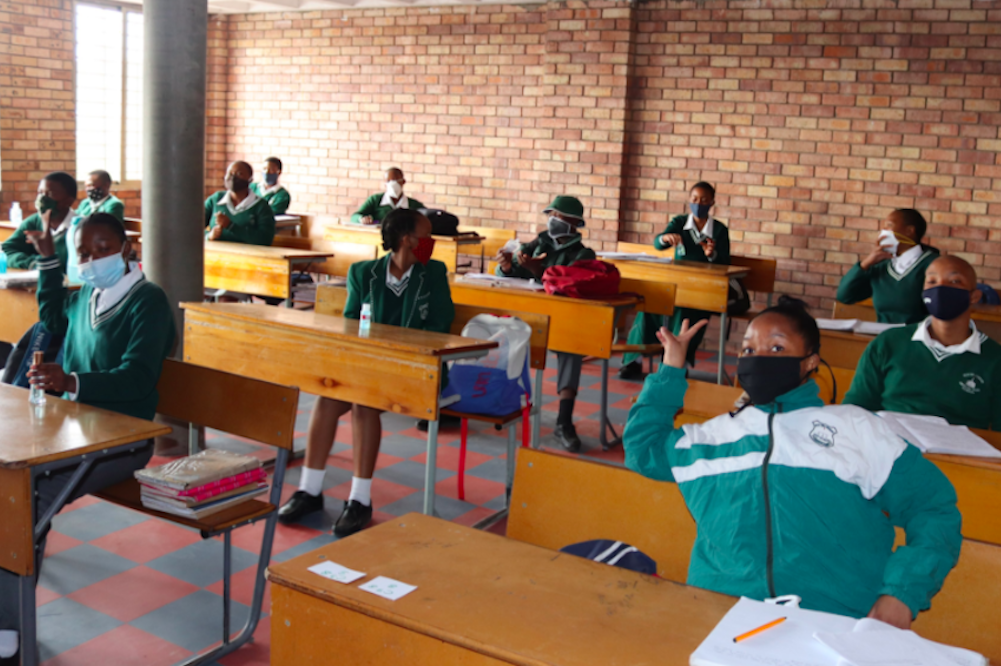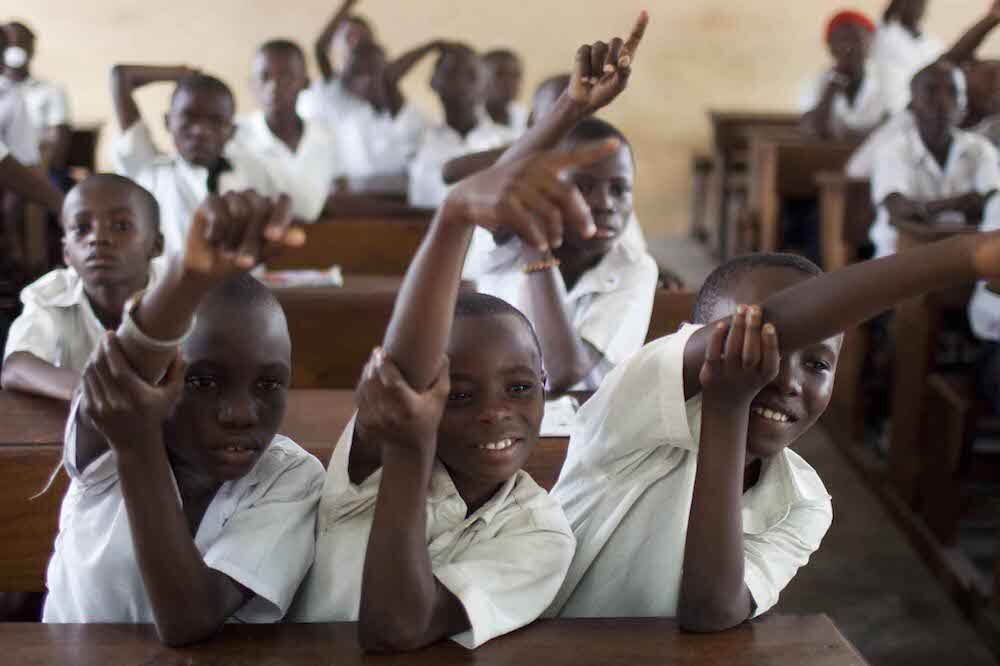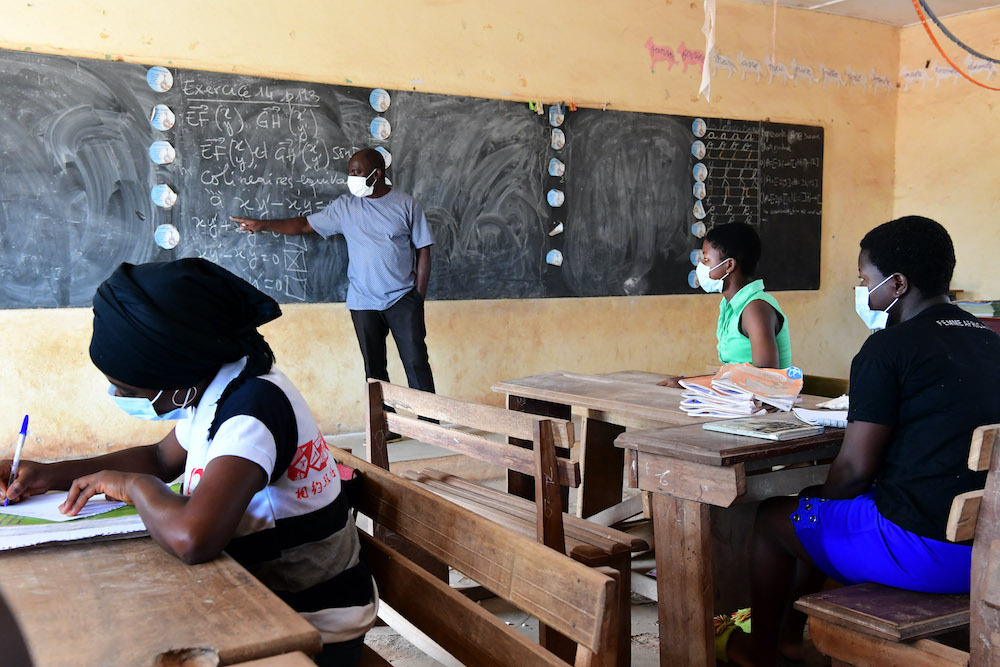Back to school – with face masks, hand sanitisers, smaller classes and no hugs

Classrooms that had been closed by the coronavirus crisis are slowly beginning to reopen around the world - here are some of the measures to make learning safe.
Picture a kindergarten or primary school classroom. What do you see? Children gathered around communal tables – swapping crayons, books and hugs with their friends?
Not now. Not in the age of coronavirus. The pandemic is changing the face of education and no one knows how long the effects will last.
About one billion children around the world remain shut out of classrooms because of school closures. Theirworld has launched the #StillLearning campaign to share fun and practical activities to help keep children educated and entertained while at home.
But some countries are cautiously reopening their education systems – and that means major alterations to the way classrooms look and operate.
Out go so many of the familiar things we all grew up with. In come hand sanitisers, temperature checks, disinfected chairs, face masks, taped markings on the floor. Socially-distant learning is the new norm.
“The teachers told us to use hand sanitiser and not to touch one another at school,” said Vu Tuan Phong, a fifth-grade Vietnamese student who returned this week to his primary class in Hanoi. School days have been shortened, so he and his friends go home at midday.
The South Asian country – which has recorded no coronavirus deaths – had closed its schools for months. But kindergartens and primaries reopened on Monday, with children’s temperatures being taken at the gates.
Several other countries began to reopen their schools this week, including Australia, Israel, Switzerland, South Korea, Netherlands, Canada, Greece and France.
In Switzerland, many schools are splitting classes in half – with each group attending two days a week. There are hand-sanitising stations, desks are further apart and markings are taped to floors to help children observe new space limits.
The Swiss government cited scientific papers supporting its view that youngsters are unlikely to pass coronavirus infections between one another or bring them home from school. But mum-of-two Marion Moussadek from Geneva said: “This is very complicated, especially with my little girl who is five years old, to explain to her that she cannot hug her teacher.”
The school that the kids are going to discover will have little to do with the school that they left behind. Teacher at a primary school in Paris
Primary schools reopened this week in the Netherlands. At the Springplank school in Den Bosch, plastic shields have been installed around students’ desks. Younger and older students will use different entrances and parents have to drop their children at the school gate.
“Our teachers are not worried,” said Rascha van der Sluijs, the school’s technical coordinator. “We have flexible screens that we bought so we can protect our teachers if students are coughing.”
In South Korea, the spring semester has been postponed four times since March during an intensive social distancing campaign. Schools started to reopen this week and Education Minister Yoo Eun-hae said: “If a student turns out to be infected with the virus, health authorities will take the necessary action and the school will switch to online classes.”
Students and teachers have to wear masks except during mealtimes, wipe their desks and maintain distance as they move around. Schools are required to carry out regular disinfection and temperature checks and to rearrange seating.
About one in four primary-age students returned to school in France this week. They sat at least a metre apart in classes of no more than 15 and listened to teachers wearing masks telling them to wash their hands, not to touch their faces and to keep away from each other.
“The school that the kids are going to discover will have little to do with the school that they left behind,” said David, a teacher at a primary school in Paris’ western 16th district who gave his first name only. “It’s more like a nursery to let the parents go back to work.”
Ten-year-old Clara Delarue returned to school in the town of Vélizy-Villacoublay near Paris. She said: “It won’t be the same school but at least it will make the virus pass. I’m happy to be back, to see my teacher, my friends and to learn in class.”
Most high school seniors in Greece returned on Monday to prepare for university entrance exams. As well as social distancing, they have been instructed not to exchange books, pens or stationery. They will also have to use keyboard covers and every chair must be disinfected before the next student sits in it.
After three months of lockdown, students in the Chinese city of Shanghai began lessons a few days ago.
“I feel so excited coming back to school,” said 17-year-old Zhang Jiayi. “Usually we look forward to the holidays but suddenly our holidays became so long. This time, we longed to go back to school, where we can see our friends and teachers.”

Students and staff enter the school building via a thermal scanner and must wear a mask, even when addressing the class. The walls are papered with posters on measures to tackle coronavirus and in the spotlessly-clean school canteen, glass walls divide the tables so only two students can eat together.
Principal Feng Zhigang said there is a psychological guidance team to help students during the isolation of online classes – but that could never be a substitute for everyone being reunited with friends and teachers. He added: “Teachers and students being together, this is the most effective.”
Israel, which closed its schools in March, started teaching the first three and last two grades of school last week. It followed that up by partly reopening nurseries and kindergartens on Sunday.
Numbers are capped at 17 children for each nursery and 18 for each kindergarten to allow for social distancing. Within each kindergarten, children are sub-divided into groups of nine. Sunday’s turn-out rate was 60% for the kindergartens and 90% at nurseries.
In Australia, the New South Wales government said it has delivered thousands of litres of soap and hand sanitiser to schools, as well as personal protective equipment and temperature monitors. Class sizes will be reduced and activities will involve minimal physical contact between the students.

Jean Marie Bomi teaches mathematics at a school in Odienné, Côte d’Ivoire (UNICEF / Frank Dejongh)
UK Prime Minister Boris Johnson announced this week that children returning to schools in England next month will be taught in “protective bubbles” of no more than 15 and kept apart from others in order to minimise risk.
Many parents are unhappy at the prospect of sending their children back to school. The Canadian province of Quebec reopened some schools on Monday. But Maude Racicot, a 37-year-old mother of three from Montreal – who is also an elementary teacher – said her children would not be attending Ecole St-Gerard in St-Jean-sur-Richelieu, where staff wearing visors greeted returning students.
She said: “We don’t know enough about the virus.”
Schools are officially closed in Cote d’Ivoire. But Jean Marie Bomi, a 45-year-old mathematics teacher in Odienné, was worried that his students were losing out.
So he teaches with a limited group of students twice a week for two hours. They clean the classroom before and after the class, respect social distance and wear a mask.
Jean Marie said: “I took the initiative because education can not wait. My students are very happy. They were not only bored at home but it was important for them not to lose time and continue practising.”